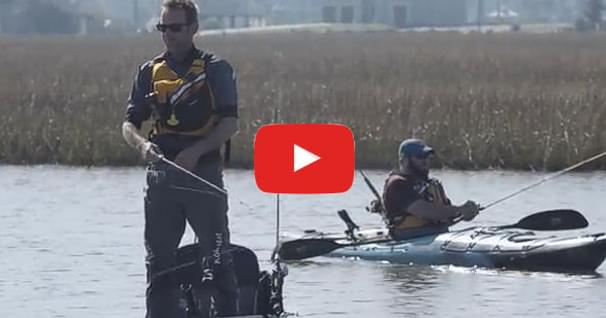Paddling Preparedness For Hunters
Paddling Safety for Hunters
Every fall and winter tens of thousands of hunters take to the water in pursuit of their quarry. Many of those do so using various paddle craft. Let’s take a minute to discuss paddling safety for hunters.
Start by making sure that you are outfitted with all of the equipment and lighting required by law. Both the required equipment for paddlers and proper lighting requirements have been covered in detail already, but those requirements apply to hunters as well.
Paddling Equipment for Hunters
Life Vest
Of the required equipment, nothing is more important than a PFD, and nothing can contribute more to survival than wearing a PFD. Statistics show that over 80% of paddlers who die are not wearing a PFD. More alarmingly, many of those didn’t even have a PFD on board. There are a number of kayak fishing life vests, even camo inflatable PFDs, on the market. While they are camo on the outside, they inflate to a bright yellow color to increase visibility. They can easily be adjusted to fit over bulky hunting clothing. There are a number of inherently buoyant camo PFDs on the market as well. Some of those are in the form of a Coast Guard approved flotation coat. Be sure to stick something high-vis like a silver emergency survival blanket in your pocket if you choose a camo PFD. Check out all PFDs available on the market here.
Cold water is often the greatest safety threat to paddling hunters. Cold water incapacitates quickly and kills unmercifully. Cold water shock is a serious danger to a paddler not wearing a PFD, and it can occur in water temps as high as 70 degrees. Likewise, so can hypothermia, so even with a PFD cold water can kill.
Cold winter winds are often present during hunting seasons. They accelerate body cooling and they can cause dangerous wave heights. Our paddle craft are small and have low freeboard. Add our bulky clothes and hunting gear such as guns, decoys, blind bags, blind material, perhaps climbing stands and sometimes even dogs, and we become much more top heavy. When winds, waves and currents are present our stability is further diminished. The risk of capsizing is very real.
Now imagine trying to perform a self-rescue with layers of heavy, soaked hunting clothing. Imagine the wind and waves pushing our paddle craft away while we are trying to catch it in the heavy clothing. Think about how cold water can immediately diminish our physical functioning. A cold water, cold weather capsize while we are bundled in hunting clothing can have disastrous consequences. The value of wearing a PFD in these conditions cannot be overstated.
Take a look at these self-rescue techniques. Practicing these techniques with a partner in a safe warm water environment, dressed in your hunting clothing, while wearing a PFD will be eye opening and is highly recommended.
Communication Device & Float Plan
Where do you keep your cell phone? How do you keep it dry? Will it work in remote locations? Do you have back up emergency communication devices like a handheld VHF radio, a PLB or EPIRB or a similar commercial satellite communication device? Plan on keeping a communication device on your person and keeping it dry if it’s not waterproof.
What happens if, despite our best efforts, we are separated from our paddle craft or otherwise stranded? Our first line of defense takes place before we leave home, when we file a detailed float plan. There’s also one contained within the very useful Go Paddling app or Coast Guard App. A photo of your craft should always accompany the float plan.
Emergency Ditch Kit
There are several different survival scenarios hunters may find themselves in. The absolute worst is being in the water separated from our paddle craft, or with it but unable to right and reenter. The cold water poses an immediate threat to our lives. Keeping a waterproof ditch box or bag on deck and immediately available gives us our best chance of survival. If we can’t access the ditch kit, our hunting jackets have the benefit of having large pockets. Dedicate a pocket to a communication device, a survival blanket, waterproof flashlight or any small useful item.
-

Some Emergency Ditch Kit Items
Some Emergency Ditch Kit Items
The more likely scenario for hunters is being stranded ashore somewhere. You’ll want to do your best to make it to shore with your ditch kit. If you keep it out on deck and immediately available, then you are likely to be able to grab it in an emergency. If not, you’ll have only what has been stowed in your jacket pocket.
Quick Review
Sadly, this year hunters will lose their lives to paddling accidents. Most fatalities are easily preventable. By applying a layered safety strategy we greatly increase our chances of not becoming a statistic. Let’s wrap up with a quick review. Be weather wise. File a float plan. Wear a life jacket. Respect and prepare for cold water and cold weather. Anticipate capsizing and be practiced in self-rescue. Have a reliable waterproof communications device on your person. Take advantage of the pockets on your hunting clothes to stow some survival items. Keep a waterproof ditch box or bag immediately available and mentally program yourself to get it in an emergency. Lastly, and we have not yet touched on this, never forget the value of the buddy system.
Related Articles
Since the last fishing video, which was my first kayak fishing video, I've been out on super early…
As the sport of kayak fishing continues to explode in popularity, more and more people are putting their…
Fishing is a lot of fun. Catching is even more fun. But in order to make either one of those…
Fishing kayaks come in all different shapes and sizes and it's important that you choose the right one.…





